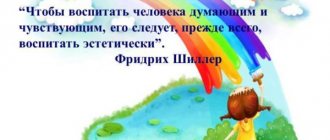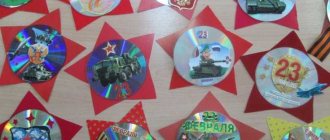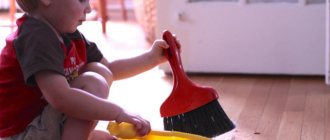Models and types of preschool education. To educators
Models and types of teaching for preschool children
Modern models of preschool education: traditional (authoritarian, educational-disciplinary model) and student-oriented. Traditional: the goal is to equip children with knowledge, skills and abilities (KAS), instill obedience, reproductive activity. The results of preschool education were assessed by the amount of knowledge: it was believed that the more “invested” in the child, the more successfully he was taught.
A distinctive feature of the educational and disciplinary model was the uniformity of content, methods and forms of teaching, i.e. training was carried out according to uniform programs, curricula and manuals. Methods of communication - instructions, explanations, prohibitions, demands, threats, punishments. The teacher’s task is to implement the program and satisfy the requirements of management and regulatory authorities. The child is the object of application of the forces of the educational system. The center of the pedagogical process is frontal forms of work with children, the class-lesson system, children’s activity is suppressed, play is strictly regulated and infringed. Results: mutual alienation of adults and children, loss of initiative by children, negativism.
The urgent need of modern society for people with independent, creative thinking prompted scientists (S.A. Amonashvili, V.V. Davydov, V.A. Petrovsky, etc.) to develop a different learning model based on personality-oriented interaction between the teacher and the child . The purpose of such training is the development of intellectual; spiritual, physical abilities, interests and motives for activities, including educational ones (i.e., the personal development of the child), the acquisition of himself as a unique individuality. To realize this goal, the child, starting from an early age of life, should support the desire to join the world of human culture by mastering the means and methods transmitted to him that are necessary for this inclusion. The teacher needs to organize children and involve them in an active process of solving cognitive and practical problems, during which each child could feel his growth, the joy of creativity and improvement.
The person-oriented model of interaction between a teacher and a child has its own pedagogical technology: the transition from explanation to understanding, from monologue to dialogue, from social control to development, from management to self-government. At the same time, learning is realized in joint activities, cooperation between the teacher and children, in which the teacher is an assistant, adviser, senior friend.
Modern researchers note that the actual educational process in kindergarten involves building a model of personality-oriented interaction between a teacher and a preschool child based on the following positions of its participants:
subject-object model - the adult is in the position of a teacher in relation to children, setting certain tasks for them and offering specific ways and actions to solve them;
object-subject model - an adult creates a developmental environment, a unique objective world in which children act freely and independently;
subject-subject model - the position of equal partners included in a common joint activity.
All presented models take place in the real pedagogical process of a preschool educational institution, and their use depends on the need to solve a variety of educational problems. In this regard, modern works examine various forms of organizing the learning process associated with these positional models and are divided accordingly into three types:
Direct acquaintance of children with the means and ways of knowing or reflecting the surrounding reality.
Direct teaching - the teacher defines a didactic task, sets it for the children, gives a sample of its implementation, and, while completing the task, directs the activity of each child to achieve a result.
Transfer of information from children to adults, when children act independently and an adult observes their activities.
Methods of activity. A problematic situation is created, which the child cannot solve with the help of existing knowledge and skills, including cognitive ones. To do this, he must turn over his experience, establish other connections in it, master new knowledge 3. An equal search by adults and children as subjects of activity for solving a problem during observation, discussion and experimentation.
Indirect learning consists in the fact that the teacher, based on the collected data on the development of children, organizes the subject-material environment: consistently selects certain means with which to optimize the process of mastering new learning skills (books, toys, etc.). Then it is necessary to include these means in children’s activities, enrich their content, and influence the development of communication and business cooperation. (so, the children exchange impressions about where they were in the summer, and the teacher takes out the atlas and visually searches, examines and studies together).
Organization based on the presented models of educational work with children is carried out through the creation of problem-based, developmental, educational situations.
Development of the second position
The development of the second conceptual position was associated with the research of L.S. Vygotsky (1896-1934), who identified the ability of preschool children to establish cause-and-effect relationships and acquire systemic knowledge. As a logical development of scientific research, the modern research trend of studying and forming a system of knowledge in preschoolers was born (V.I. Loginova, St. Petersburg). Based on this approach, in the textbook “Preschool Pedagogy” (1988) edited by P.G. Samorukova and V.I. Loginova proposes the principle of systematic knowledge, which is interpreted by modern teachers in two ways: firstly, as the organization of knowledge, and secondly, as the creation of systemic knowledge.
Modern preschool institutions are developing variable approaches to teaching children and focusing on the use of innovative methods and technologies (elements of solving creative research problems, problem-based learning, as well as modeling, technical teaching aids, etc.). To do this, it is necessary to include the existing personal experience of children in the process of collective or individual search activity under the guidance of a teacher. The success of this activity depends on children's communication skills and ability to interact.
Indirect, indirect learning directs the preschooler to complete a research task in his own way, chosen by each student in accordance with his abilities and needs and associated with the use of various opportunities to expand the “field”, “space” of the child’s learning, his independent research activities. “Space” can be organized: firstly, in reality - by creating material conditions for self-restoration, self-education and self-development of a child in a specific, specially created developmental environment that corresponds to the age characteristics of preschoolers; secondly, indirectly - through the development of new technologies for active interaction and cooperation between teachers and students and the organization of various variations of children's activities.
The first direction of organizing “real space” has been widely developed in modern research, related, among other things, to the introduction of the Montessori methodology and Waldorf pedagogy (the anthroposophical concept of R. Steiner) into the work of Russian kindergartens. These theoretical concepts are based on the creation of a developing and nurturing environment that serves as a background and facilitator for active interaction between children and adults, and are based on the implementation of a person-centered learning model. An enriched or developmental environment today is understood as a natural, comfortable, cozy, rationally organized environment, full of a variety of sensory stimuli and play materials, in which children can engage in cognitive and creative activities. Such space has a significant impact on the child’s learning process. T.I. Babaeva, L.M. Klarina, V.A. Petrovsky, L.A. Smyvina, L.P. Strelkova identified the principles on which this space is built: privacy, ensuring a subject-subject position in interaction; activity; independence; stability-dynamism; emotionality; individual comfort; saturation; structure; a combination of familiar and unusual elements in the aesthetic organization of the environment; openness-closedness; taking into account gender and age differences in children.
A developmental environment based on these principles allows the child to show his own activity and fully realize his potential. In this case, multidimensional play, as the main form of children’s life in the designed space, becomes an activity based on the free cooperation of children with each other and with adults. The developing environment, in turn, becomes a real condition for the manifestation of individuality, independence and activity of children, leveling out excessive paternalism and unjustified regulation of actions on the part of teachers. It is the subject environment, its content and zoning that determine the implementation of the vital (organic), emotional and cognitive needs of children, which become an important factor in the successful socialization of preschool children and their familiarization with the existing cultural heritage.
The second direction of organizing “real space” is realized through emphasizing the activity aspect in the organization of the educational process. The creation of interesting, meaningful activities, filled with positive emotional experiences for the child, the joy of creativity and self-expression, is considered the main condition for the active assimilation by preschoolers of the cultural achievements of society. Modern preschool psychology and pedagogy, while recognizing the importance of the theory of leading activity for understanding the mechanisms of child development, still emphasizes the position that in real life the child participates not in one, but in a whole system of different types of activities. Thus, for preschool didactics, the question is not in what type of activity the child’s personality primarily develops, since this leads to opposition and ignoring of individual types of activity, but in using each type of children’s activity for the full, dynamic development of the child.
Methods of teaching preschool children
Teaching method is a historical category.
Thus, teaching methods based on imitation predominated in ancient times. By observing and repeating certain actions, such as work, following the example of adults, students mastered them through direct participation in the life of the social group to which they belonged.
Since the organization of schools, verbal teaching methods have appeared. The main method of teaching was the transmission of ready-made information by the teacher in the form of written, oral, and later printed words, and its subsequent assimilation by students. The word became the main carrier of information, and learning through books became one of the main goals of education.
In the age of great discoveries and inventions, verbal methods are gradually losing their importance as the only way to transfer knowledge to students.
Methods of visual teaching and methods have been developed to help apply knowledge in practice.
At the turn of the nineteenth and twentieth centuries, the concept of "learning through activity" with hands-on teaching methods gained interest. Great hopes were placed on the next version of the verbal method, which is based on the independence of the movement towards knowledge. However, this method requires too much work and time to achieve results.
This is debatable.
Regardless of the role that different teaching and learning methods have played in different periods of educational development, none of them, when used alone, achieves the desired results.
Since no one method is universal, good results can only be achieved by using many methods. But in order for a teacher to be able to use all the variety of teaching methods, they need to be streamlined and brought into a certain system.
First, let's define what is a teaching method?
A teaching method is a way in which teachers and students work together to achieve learning goals. One might also add that this is the heart of the educational process, the link between the intended goal and the final result; from Greek - literally: the path to something.
Each method consists of separate elements called methods (for example, methods of working with a book include creating a reading plan, retelling, creating notes, etc.).
A set of techniques that make up a method and serve to solve didactic problems (didactics from Greek - learning associated with teaching).
Familiarization with new material, acquisition of skills and abilities, their consolidation and application.
Given the two-way nature of the teaching method, it is necessary to be able to distinguish between teaching methods that perform informative and controlling functions (the teacher explains, shows, instructs) and teaching methods (the student listens, observes, reads).
Thus, to consolidate the material, the student performs a series of exercises proposed by the teacher, while the teacher analyzes the student’s actions, analyzes mistakes, organizes new exercises to consolidate successes, and checks the results.
Oral presentation as a teaching method not only includes information from the teacher, but is also a student activity aimed at perceiving and understanding the material.
The teaching method always involves the activity of a leader and a follower. This is its peculiarity.
The peculiarity is that the teacher, while controlling the student’s activities, must see the external and internal aspects of the teaching method.
The process of cognition that a student performs is often hidden from the teacher; the external side of his activity (the student observes, reads, listens) does not yet reveal the process of cognition itself, its qualitative side. One and the same externally expressed activity of a student can be completely different in its qualitative expression inside.
Thus, when reading, a student can only pursue the goal of assimilating ready-made information, but it can also be a research activity aimed at solving a cognitive problem. Knowledge gained through search activities is more conscious, permanent, and mobile. It is easier for the student to apply it in practice.
The discovery of knowledge stimulates the development of his thinking, imagination, and creativity. Thus, the educational value of the method is determined by the internal, often hidden side of the cognitive process, and not by the external form of its expression.
The peculiarity of teaching methods is also that they are not static, but develop. The development of the method is associated with a change in the student’s position in the learning process. Teaching gradually strengthens student independence in learning, increasing the possibility of inclusive self-education. This problem is solved by the teacher in the process of managing student learning.
In modern didactics there is still no single, generally accepted classification of methods. The most common classification of methods according to sources of knowledge, according to which all teaching methods are divided into visual (demonstration, illustration, excursions), verbal (live teacher, conversation, working with a book) and practical (exercises, creative work, laboratory, graphic). This classification does not reveal the internal processes that constitute the essence of the method. In the group of methods for organizing and conducting pedagogical actions and operations, subgroups can be distinguished: Perceptual methods, which include methods of verbal transmission and auditory perception of educational information (abbreviated as verbal methods: story, lecture, conversation, etc. These include methods of visual transmission and visual perception of educational information (abbreviated as visual methods: Illustrations, demonstrations, etc.); methods of transmitting educational information through practical, labor activity and tactile, kinesthetic perception (abbreviated as practical methods: Exercises, laboratory experiments, labor-like activities, etc. .d.). A subgroup of logical methods, including methods identified on the basis of the leading logical operations used in the thinking process: inductive, deductive and other methods. A subgroup of gnostic methods, identified on the basis of an assessment of the degree of the search nature of thinking: reproductive, problem-search, research, etc. The methods of the first and second subgroups can be implemented both under the guidance of a teacher and independently. Therefore, all of them can be divided into two subgroups of management and self-government methods, or more precisely: methods of work under the guidance of a teacher and methods of independent educational work (working with a book, homework), as well as methods of control and self-control (methods of oral, written laboratory work, machine control, self-testing of one’s knowledge).



